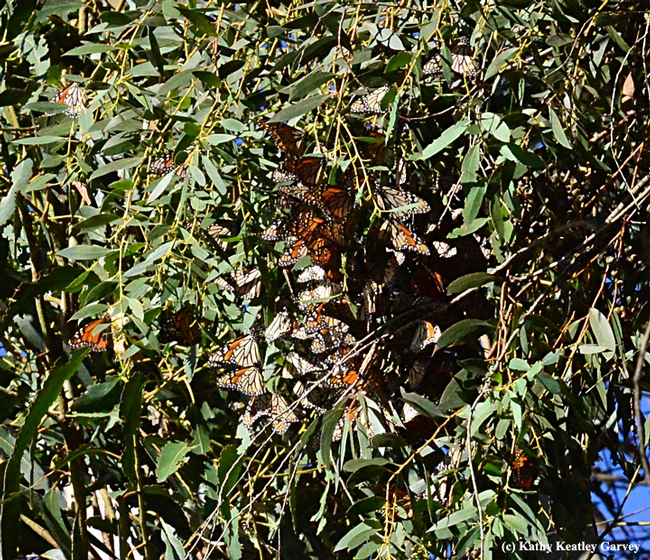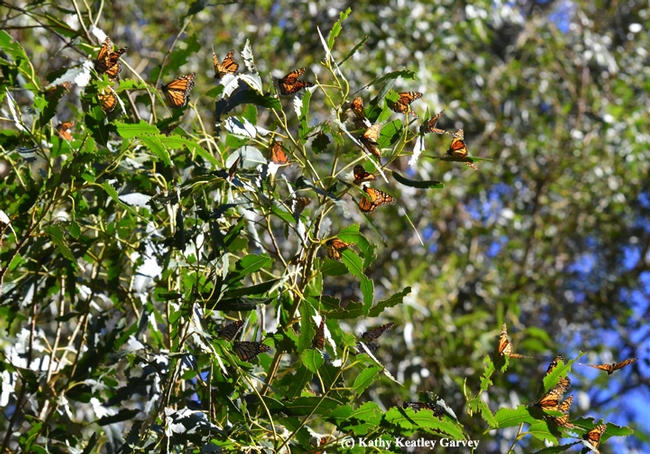
From 75 to 80 feet below, they bore no resemblance to monarch butterflies (Danaus plexippus), the most familiar butterfly in all of North America.
"Wait 'til the sun shines on them," a docent whispers. "That will be about 10 to 15 minutes." State park rangers and docents do not yell; they whisper.
At around 11 a.m. on Saturday, Dec. 27, the sun's rays struck the cluster. Soon after, a bluejay scattered them.
The crowd below broke into applause. It's not often that a crowd applauds a miracle of nature, but that's exactly what it is. A miracle of nature as roosting monarchs winter in a Eucalyptus grove.
The Natural Bridges State Park is the only monarch butterfly preserve in the United States, according to a park publication. More than 100 permanent overwintering colony sites dot the California coast. They include Pismo Beach and Pacific Grove.
At the Natural Bridges State Park Visitors' Center, guests can see the four stages of the monarch: egg, larva, chrysalis and adult. Milkweed, the host plant, grows in a demonstration garden outside. Last Saturday the milkweeds were blooming as if were spring.
The winter-generation monarchs are usually born in late August or September "as the sun's rays and the days begin to shorten," according to a park publication. "This shortening of the light seems to trigger several important changes in these monarchs:

(2) They have the ability to store fat, which summer generations do not have, and they feed earnestly to build up stored body fats for the migration and the overwintering periods.
(3) They begin a serious migration to safe wintering roosts. They arrive at sites in California during October and in Mexico in November.
(4) At the wintering sites, they reduce their activity, extend their life span and wait until spring, usually February, to begin mating activities and producing the next generation of monarchs."
The roosting monarchs cluster like shingles on the limbs, needles and leaves of a number of trees, including the Eucalyptus, native to Australia. Among the other trees they favor: native Monterey pine, Monterey cypress and sycamore.
How are the monarchs able to hold on? With their tarsi, or backfacing claws. They roost in areas where winter temperatures don't dip to freezing. "The monarchs are looking for the refrigerator, not the freezer" in order to slow their metabolism, a park publication pointed out.

Other predators include the chestnut-backed chickadees, mockingbirds, phoebes, shrews and mice. In addition, several flies and wasps lay their eggs on the caterpillar.
School children touring the preserve soon learn how they differ from monarchs. Humans have two legs; butterflies have six legs; humans travel with their feet; butterflies with their wings; human smell with their noses; butterflies smell with their antennae. Humans taste with their tongues; butterflies have taste sensors on their feet, which are reportedly 2000 times more sensitive than the human taste buds.
Unfortunately, North America's monarch butterfly population is declining. Wintering groves are disappearing due to coastal development in California and logging in Mexico. And inland, loss of milkweed resources means a loss of their host plant. The Xerces Society for Invertebrate Conservation recently related that the North America population of Monarchs has decreased by 90 percent in the past 20 years.
The good news, however, is that we humans are focused on the plight of the Monarch.
On Dec. 29, a Xerces press release proclaimed: "Monarch Butterfly Moves Toward Endangered Species Act Protection."
"In response to a petition by the Center for Biological Diversity, Center for Food Safety, Xerces Society and renowned monarch scientist Dr. Lincoln Brower, the U.S. Fish and Wildlife Service said today that Endangered Species Act protection may be warranted for monarch butterflies," the press release began. "The agency will now conduct a one-year status review on monarchs, which have declined by 90 percent in the past 20 years."
Sarina Jepsen, the Xerces Society's endangered species director, was quoted as saying: “We are extremely pleased that the federal agency in charge of protecting our nation's wildlife has recognized the dire situation of the monarch. Protection as a threatened species will enable extensive monarch habitat recovery on both public and private lands.”
Attached Images:


